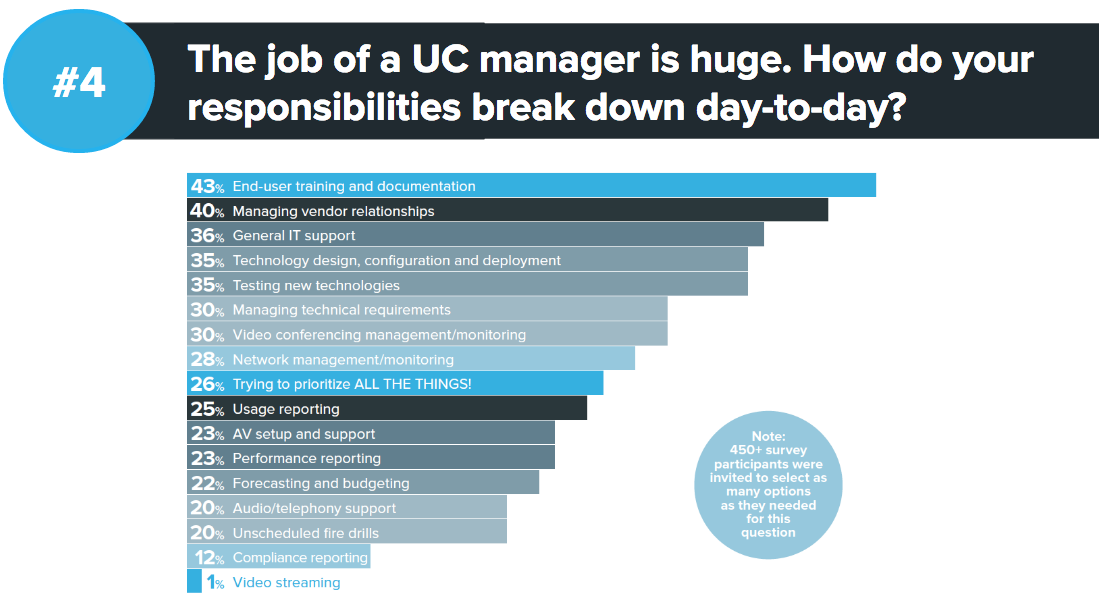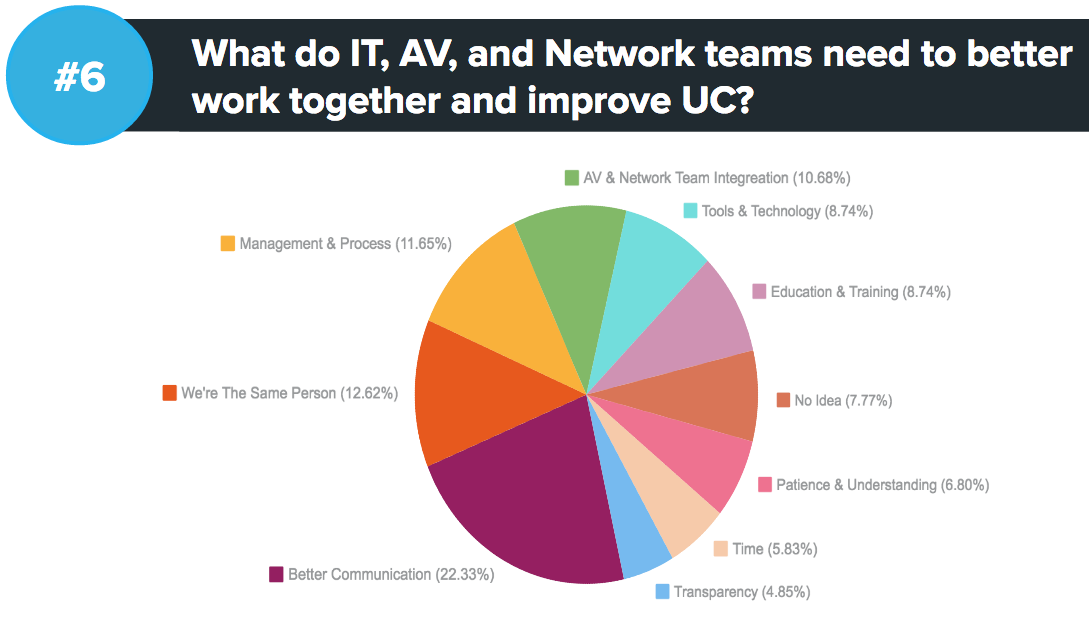Hi, and a happy 2017 to you! I always enjoy the beginning of a new year especially when it comes to the world of technology. There is so much to look back on and so much more in which to look forward (is THIS the year of virtual reality?? I think not). It was a fun experience to join Vyopta’s State of Unified Communications Panel webinar late last year. The survey results and answers to poll questions provided some great insight from those in the industry who support or plan to launch unified communications (UC) solutions this year.
So, whether you attended or not, let’s take a quick review as there were some fascinating trends that are applicable to UC admins and stakeholders alike.
Only 54% of Survey Participants Feel Unified Communications Has a Positive Impact
Webinar Slide Excerpt: The State of UC & What to Expect in 2017 ©Vyopta Inc. 2016
Here we are in 2017, technology advancing at light speed before our eyes, in a connected world that helps bring us closer and work better together, and only 54% of survey respondents think the UC movement is a good thing! I am surprised but at the same time understanding of these results. The way I see it we have several major issues:
- Network/AV/VoIP/Support teams are often told not only find, but also deploy a technology with no strategy behind it. There has to be a reason to deploy a UC platform with clear goals. What exactly are we trying to accomplish? This question is rarely asked.
- Teams charged with finding, deploying, and supporting a platform are also being asked to do end user training. Training and onboarding are essential to a successful UC deployment but do you really want the people who keep your network or your conference rooms running spending time creating documents and training your users?
- Once a solution is vetted and decided upon, there is rarely proper communication to users regarding how to use it, but more importantly why the company wants them to use it.
- Many providers aren’t concerned with assisting with your strategy. They are concerned with selling you their product, implementing it, and supporting it, but rarely are they focused on specific details that will make the solution work best for the way you do business.
Combine all these points and you’re looking at quite a problem. You’ve invested a lot of money in launching a technology that many don’t feel is helpful! When your users are asked to use tools without receiving proper communication about how the solution works or why you want them to use it, it just feels like more work on top of their everyday duties. Who wants that? A proper plan and effective communication around your UC platform is the best way for these survey numbers to go up.
…And About That Training and End-User Documentation Thing
As touched on above, UC managers responding to the survey said 43% of day to day responsibilities included end user training and documentation. I’ll ask again, do you want the people tasked with keeping the lights on creating training programs? Sure it is needed but should it be their job? This is a tough one because administrators of the technology know it best and therefore are in the best position to give training. However when you have a large network with many offices, conference rooms, and users to support, training and user communication usually takes a back seat to making sure things are up and running.
Webinar Slide Excerpt: The State of UC & What to Expect in 2017 ©Vyopta Inc. 2016
In my opinion, this is where strategy comes into play once again. Perhaps your L&D team can be trained on your platform of choice and offer new employees info during onboarding or create helpful short training videos. Maybe marketing can get involved in sharing the best reasons to use your solution to your employees. Or maybe you can identify your power users (perhaps with a nifty analytics tool like Vyopta?), ask why they love it, and how they use it best so you can create some training material with their help. It is also possible that we might see a hybrid role emerge in larger companies where you have a collaboration evangelist/training expert. There is no doubt these services are needed. Training is extremely important but your support teams shouldn’t be doing it for 43% of their day.
The Struggle of Modernizing Your Video Platform Is Real
During the webinar we had some live questions from participants regarding the struggle of modernizing their current UC deployments. Trust me, I’ve been there, and the struggle is real. You have a dispersed environment of equipment and practices that are outdated, lacking features you need to get work done in the modern world. Thousands (or perhaps millions) were spent on this old platform and the idea of ripping everything out, putting new gear in, and organizing the smoothest transition possible is a daunting thought. You also have the large issue in that many of your users will be resistant to learning a new technology.
Complaining about how hard it is won’t get the job done. There are several approaches you can take to make this task easier. For one, I will beat the strategy horse again. Make sure you define some clear goals in what you need from your UC platform of the future and look at it as an exciting opportunity to do bring some new, interesting, and fun components to your business. Next, a platform with good interop is key in a major transition. Interop allows your older gear to speak with more modern equipment. There are great providers out there like Pexip who do this very well on top of additional features to expand the reach of your old environment without having to fully replace everything. Last, find the champions of your strategy, the ones who are excited about new tech. Talk to them! Let them help you form a communication strategy that will explain why a transition is necessary and exciting.
The Skype for Business Takeover

I’ve seen many businesses implement S4B only to realize that the video component is sorely lacking in features that help tie everyone together in today’s connected world. Imagine implementing a brand new solution and having to find and pay for an add-on that extends its reach shortly thereafter. Don’t get me wrong, Skype for Business is a great platform for certain scenarios, and who knows how it will be improved in 2017 (my guess is through partnership or acquisition of another company that specializes in video interop), but make sure you know what your needs are before deciding it is the UC platform for your company in 2017.
How IT, AV, and Network Teams Can Improve Unified Communications
Webinar Slide Excerpt: The State of Unified Communications & What to Expect in 2017 ©Vyopta Inc. 2016
A final survey response that I thought was interesting: in the question of “what do IT, AV, and network teams need to better work together and improve UC?”, the leading answer at 22.3% was: “Better Communication”. This fits in nicely with the trends of a need for proper planning and goals in place. Teams are so busy keeping the lights on, managing vendor relations, and their regular day to day, it is hard to communicate and organize a proper support structure to run and grow the platform.
Unified communications is still an emerging need that often has no clear business owner or direct support team. It requires assistance in the form of proper implementation and training to make the investment successful. Stakeholders and executives who want their teams to deliver this technology must realize that a good solution is only as good as the purpose behind it and have the proper mechanisms in place to launch and support that strategy. This way communication between support teams should not be an issue and users know who to talk to when they have a question or when something isn’t working properly. Easier said than done, but a little up-front planning can save a lot of confusion down the road.
Thanks to everyone for reading! It was a pleasure to take part in the webinar as well as this recap. Please direct any questions or comments below. I’d love to continue the conversation!









